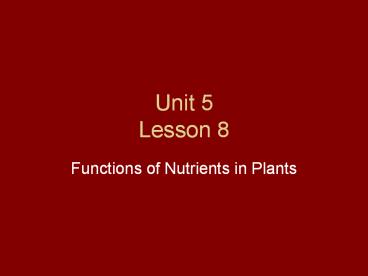Unit 5 Lesson 8 - PowerPoint PPT Presentation
1 / 19
Title:
Unit 5 Lesson 8
Description:
Unit 5 Lesson 8 Functions of Nutrients in Plants – PowerPoint PPT presentation
Number of Views:83
Avg rating:3.0/5.0
Title: Unit 5 Lesson 8
1
Unit 5Lesson 8
- Functions of Nutrients in Plants
2
Sixteen plant food nutrients
- Essential for proper crop development
- Each is equally important to the plant
- Required in vastly different amounts.
- Three categories
- Primary (macro) nutrients
- Secondary nutrients
- Micronutrients.
3
PRIMARY (MACRO) NUTRIENTS
- Primary (macro) nutrients
- nitrogen
- Phosphorus
- Potassium
- They are the most frequently required in a crop
fertilization program. - Also, they are need in the greatest total
quantity by plants as fertilizer.
4
NITROGEN
- Necessary for formation of amino acids
- the building blocks of protein
- Essential for plant cell division
- Vital for plant growth
- Directly involved in photosynthesis
- Necessary component of vitamins
- Aids in production and use of carbohydrates
- Affects energy reactions in the plant
5
PHOSPHORUS
- Involved in photosynthesis
- Respiration
- Energy storage and transfer
- Cell division, and enlargement
- Promotes early root formation and growth
- Improves quality of fruits, vegetables, and
grains - Vital to seed formation
- Helps plants survive harsh winter conditions
- Increases water-use efficiency
- Hastens maturity
6
POTASSIUM
- Carbohydrate metabolism and the break down and
translocation of starches - Increases photosynthesis
- Increases water-use efficiency
- Essential to protein synthesis
- Important in fruit formation
- Activates enzymes and controls their reaction
rates - Improves quality of seeds and fruit
- Improves winter hardiness
- Increases disease resistance
7
SECONDARY NUTRIENTS
- The secondary nutrients are
- calcium
- magnesium
- sulphur
- For most crops, these three are needed in lesser
amounts that the primary nutrients. - They are growing in importance in crop
fertilization programs due to more stringent
clean air standards and efforts to improve the
environment.
8
CALCIUM
- Utilized for Continuous cell division and
formation - Involved in nitrogen metabolism
- Reduces plant respiration
- Aids translocation of photosynthesis from leaves
to fruiting organs - Increases fruit set
- Essential for nut development in peanuts
- Stimulates microbial activity
9
MAGNESIUM
- Key element of chlorophyll production
- Improves utilization and mobility of phosphorus
- Activator and component of many plant enzymes
- Directly related to grass tetany
- Increases iron utilization in plants
- Influences earliness and uniformity of maturity
10
SULPHUR
- Integral part of amino acids Helps develop
enzymes and vitamins Promotes nodule formation
on legumes Aids in seed production
Necessary in chlorophyll formation (though it
isnt one of the constituents)
11
MICRONUTRIENTS
- The micronutrients are boron, chlorine, cooper,
iron, manganese, molybdenum, and zinc. These
plant food elements are used in very small
amounts, but they are just as important to plant
development and profitable crop production as the
major nutrients. Especially, they work "behind
the scene" as activators of many plant functions.
12
BORON
- Essential of germination of pollon grains and
growth of pollen tubes - Essential for seed and cell wall formation
- Promotes maturity
- Necessary for sugar translocation
- Affects nitrogen and carbohydrate
13
CHLORINE
- Not much information about its functions
- Interferes with P uptake
- Enhances maturity of small grains on some soils
14
COPPER
- Catalyzes several plant processes
- Major function in photosynthesis
- Major function in reproductive stages
- Indirect role in chlorophyll production
- Increases sugar content
- Intensifies color
- Improves flavor of fruits and vegetables
15
IRON
- Promotes formation of chlorophyll
- Acts as an oxygen carrier
- Reactions involving cell division and growth
16
MAGANESE
- Functions as a part of certain enzyme systems
- Aids in chlorophyll synthesis
- Increases the availability of P and CA
17
MOLYBDENUM
- Required to form the enzyme "nitrate reductas"
which reduces nitrates to ammonium in plant - Aids in the formation of legume nodules
- Needed to convert inorganic phosphates to organic
forms in the plant
18
ZINC
- Aids plant growth hormones and enzyme system
- Necessary for chlorophyll production
- Necessary for carbohydrate formation
- Necessary for starch formation
- Aids in seed formation
19
3 Additional Nutrients
- In addition to the 13 nutrients listed above,
plants require - Carbon
- Hydrogen
- Oxygen
- extracted from air and water to make up the bulk
of plant weight.































